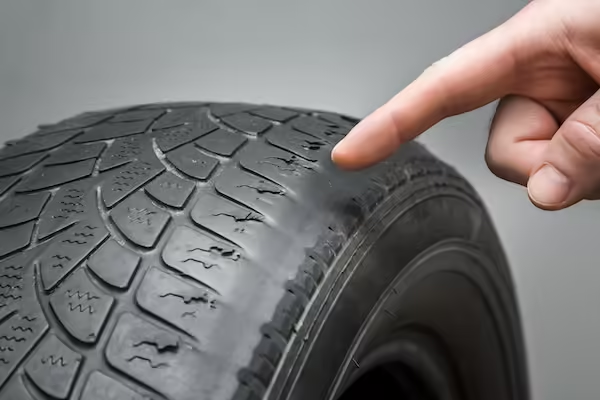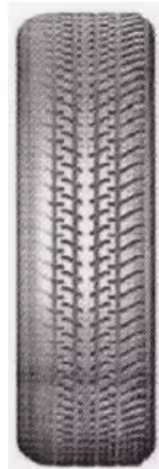What Your Tire Tread is Telling You:

Introduction
Have you ever noticed unusual tire tread wear patterns on your car’s tires? Believe it or not, those patterns can reveal a lot about your vehicle’s condition. From under-inflation to misaligned wheels, tire tread wear patterns are like a secret language that, once understood, can save you money and keep you safe on the road. In this guide, we’ll break down the common types of tire wear, what they mean, and how to fix them.
1. Center Wear: High Inflation
If your tire tread is mostly worn down the middle, this usually means your tires are over-inflated. Over-inflation can reduce the contact area with the road, leading to less grip and faster wear.
Solution: Check your car’s manual for the recommended tire pressure and adjust accordingly to ensure even wear and improved traction.

2. Shoulder Wear: Low Inflation
Worn edges with an intact center usually signal under-inflation. This reduces fuel efficiency and increases wear on the edges, leading to frequent tire replacements.
Solution: Regularly check your tire pressure, especially before long trips. Under-inflated tires also affect fuel consumption, so keeping them properly inflated saves money at the pump.

3. Feathering: Misalignment
Feathered tread blocks – where the edges of the tire tread blocks are sharp on one side and rounded on the other – indicate that your tires are misaligned. This wear pattern can affect handling and increase noise.
Solution: Get a professional alignment. Regular alignments help prevent feathering and ensure a smooth driving experience.

4. Heel-toe Wear: Lack of Rotation
Heel-toe wear, where the tire tread blocks look worn from front to back, often results from a lack of tire rotation. Uneven wear reduces your tires’ lifespan and compromises safety.
Solution: Rotate your tires every 5,000-7,000 miles to encourage even wear. This simple step can extend the life of your tires by thousands of miles.
see my famous blog: Tips to Keep Your Car Running Like New
5. Scalloped Edges: Suspension Issues
If you notice a series of hills and valleys on the tire’s surface, it’s likely due to worn-out shocks or suspension components. These components help stabilize your car, and wear can lead to bumpy, uncomfortable rides.
Solution: Schedule an inspection for your shocks and suspension. Replacing these components as needed not only prolongs tire life but also enhances overall vehicle stability.
6. Inner or Outer Edge Wear: Excessive Camber or Toe-In
Worn edges on just the inner or outer side of the tire often indicate an alignment issue, specifically camber or toe-in problems. Misalignment can also lead to steering difficulties.
Solution: Adjusting the camber or toe angle is best left to professionals. Proper alignment enhances handling and fuel economy while reducing tire wear.
7. Flat Spots: Hard Braking or Locked Brakes
If your tires have flat spots, it could be due to hard or sudden braking. Flat spots create vibration and reduce traction, making driving uncomfortable and less safe.
Solution: Avoid sudden stops whenever possible. If flat spots are already present, consider replacing the tires and have your brakes checked to avoid future damage.

How Tire Care Saves You Money
Regular tire maintenance can save you hundreds, if not thousands, of dollars. Proper inflation and alignment not only extend tire life but also improve fuel efficiency by reducing rolling resistance. Even a small improvement in fuel efficiency translates to significant savings over time, especially for frequent drivers.
Conclusion
Understanding the wear patterns on your tires gives you insight into more than just your tire health – it reflects your car’s overall condition. Regular checks and adjustments can keep you safe, enhance performance, and save money in the long run.
What is there for you
Take a few minutes to inspect your tires today. If you spot any unusual wear patterns, take action. Share this guide with friends and family – let’s keep our cars safer and more cost-effective, one tire check at a time!
